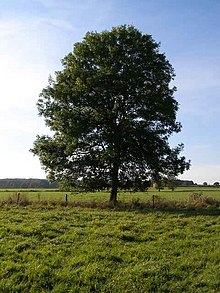Portal:Trees
The Trees Portal

In botany, a tree is a perennial plant with an elongated stem, or trunk, usually supporting branches and leaves. In some usages, the definition of a tree may be narrower, including only woody plants with secondary growth, plants that are usable as lumber or plants above a specified height. In wider definitions, the taller palms, tree ferns, bananas, and bamboos are also trees.
Trees are not a monophyletic taxonomic group but consist of a wide variety of plant species that have independently evolved a trunk and branches as a way to tower above other plants to compete for sunlight. The majority of tree species are angiosperms or hardwoods; of the rest, many are gymnosperms or softwoods. Trees tend to be long-lived, some reaching several thousand years old. Trees evolved around 370 million years ago, and it is estimated that there are around three trillion mature trees in the world currently.
A tree typically has many secondary branches supported clear of the ground by the trunk, which typically contains woody tissue for strength, and vascular tissue to carry materials from one part of the tree to another. For most trees the trunk is surrounded by a layer of bark which serves as a protective barrier. Below the ground, the roots branch and spread out widely; they serve to anchor the tree and extract moisture and nutrients from the soil. Above ground, the branches divide into smaller branches and shoots. The shoots typically bear leaves, which capture light energy and convert it into sugars by photosynthesis, providing the food for the tree's growth and development.
Trees usually reproduce using seeds. Flowering plants have their seeds inside fruits, while conifers carry their seeds in cones, and tree ferns produce spores instead.
Trees play a significant role in reducing erosion and moderating the climate. They remove carbon dioxide from the atmosphere and store large quantities of carbon in their tissues. Trees and forests provide a habitat for many species of animals and plants. Tropical rainforests are among the most biodiverse habitats in the world. Trees provide shade and shelter, timber for construction, fuel for cooking and heating, and fruit for food as well as having many other uses. In much of the world, forests are shrinking as trees are cleared to increase the amount of land available for agriculture. Because of their longevity and usefulness, trees have always been revered, with sacred groves in various cultures, and they play a role in many of the world's mythologies. (Full article...)
Durio graveolens, sometimes called the red-fleshed durian, orange-fleshed durian, or yellow durian, is a species of tree in the family Malvaceae. It is one of six species of durian named by Italian naturalist Odoardo Beccari. The specific epithet graveolens ('strong smelling' or 'rank') is due to the odor. Although most species of Durio (most notably Durio dulcis) have a strong scent, the red-fleshed type of D. graveolens has a mild scent. It is native to Southeast Asia.
D. graveolens is an edible durian, perhaps the most popular 'wild' species of durian, and it is sold commercially regionally. However, its congener Durio zibethinus is the typical species eaten and dominates sales worldwide. (Full article...)
Did you know? -
- ... that a fellow artist said of Allen Butler Talcott that "no one was his peer in the knowledge of trees and how to paint them" (painting of oak pictured)?
- ... that sex scenes in the controversial 1967 film I Am Curious (Yellow) were shot inside the Rumskulla oak, an oak tree that is more than 1,000 years old?
- ... that the red nose-like structure of the cherrynose cicada contains muscles that help it suck xylem out of trees?
- ... that extracts from leaves of the mahogany tree suren toon are used as antibacterial poultices?
- ... that The Greening of Detroit has planted over 81,000 trees in the Michigan city since the organization's inception in 1989?
- ... that the vinhática tree, Plathymenia reticulata (pictured), provides the preferred timber for making dugout canoes in Brazil, because it is resistant to rotting?
Selected article -
Populus section Aigeiros is a section of three species in the genus Populus, the poplars. Like some other species in the genus Populus, they are commonly known as cottonwoods. The species are native to North America, Europe, and western Asia. In the past, as many as six species were recognized, but recent trends have been to accept just three species, treating the others as subspecies of P. deltoides.
They are large, deciduous trees that are 15–30 m (50–100 ft) tall and diameters of 4 m (13 ft), distinguished by thick, deeply fissured bark and triangular-based to diamond-shaped leaves that are green on both sides (without the whitish wax on the undersides) and without any obvious balsam scent in spring. An important feature of the leaves is the petiole, which is flattened sideways so that the leaves have a particular type of movement in the wind. (Full article...)
General images
Selected lists
Subcategories
Related portals
Associated Wikimedia
The following Wikimedia Foundation sister projects provide more on this subject:
-
Commons
Free media repository -
Wikibooks
Free textbooks and manuals -
Wikidata
Free knowledge base -
Wikinews
Free-content news -
Wikiquote
Collection of quotations -
Wikisource
Free-content library -
Wikispecies
Directory of species -
Wikiversity
Free learning tools -
Wiktionary
Dictionary and thesaurus


















































































